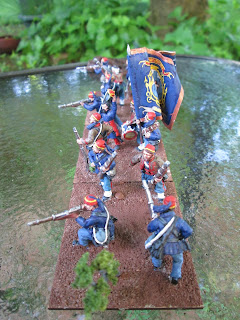I present here the 10th New York State Volunteer Infantry, also known as the National Zouaves or, early on, as McChesney's Zouaves. The 10th was the second regiment in Gouverneur Warren's elite brigade, which had the special distinction of being assigned to Sykes' "Regular" division, otherwise composed exclusively of US Army regiments. At Second Bull Run, Warren's brigade arrived with Porter's corps and on the 30th remained on the extreme left of the Union line as a precaution. By mid-afternoon, it had moved to the edge of a field off the western face of Chinn Ridge, with Young's Branch behind it. Warren ordered six companies of the 10th into the edge of a woodlot as skirmishers, while the other four remained to the left of their sister regiment. At about 4PM, the Confederates with whom skirmishers were exchanging fire rose as one man and advanced, heralding the beginning of Longstreet's assault. The six companies immediately came under heavy fire and, being in skirmish order, had no hope of resisting the advance, so they fell back rapidly and attempted to form up with the four other companies on the 5th's left. With much of the 10th scattered across a wide front, however, this was no easy task, and the regiment soon came under a withering fire from the 5th Texas off its flank that scotched any chance at putting up organized resistance. By this time, the 5th NY was buckling, and Warren ordered a withdrawal, which went unheeded but proved unnecessary, since the men soon broke and tried to make it over Young's Branch to safety. During this action, the 10th got off more lightly than the 5th, presumably because it was a less tempting target; all the same, the National Zouaves suffered 115 casualties, approaching 25% of their strength.
Here we see Colonel John Bendix, an able soldier and enthusiastic recruiter, trying to call in his skirmishers and form up on the left flank of the 5th NY. There are only 15 models rather than my usual 18, to signify the absence of the skirmishers who could not rejoin the colors. The tree on the left represents the scrub growth at the edge of the woodlot where the skirmish line had been posted.
The matter of the regimental uniform was of great interest to me. The 10th had three different official uniforms over the course of the war. The first was a dark blue and red affair with a white havelock, which seems to have proved as unpopular with the National Zouaves as with everyone else and was soon discarded (the havelock, I mean). In October of '61, the original uniform was replaced and the men issued with a distinctive (and as far as I know unique) color combination of sky-blue pantaloons and middle-brown jackets, along with red trim, fez, sash, and vest. This uniform was badly worn during the heavy campaigning in the first part of 1862, and a third, fairly standard blue uniform was ordered in September '62 and reached the regiment at an uncertain later date. So what did the 10th wear at Second Bull Run? Had the second uniforms been totally (but temporarily) replaced by the standard Union dress? Were the men still wearing their brown uniforms?
Brian Pohanka's writings on the action at Chinn Ridge state that the 10th was largely in regulation dress, which, since I was looking forward to something more colorful and unusual, was rather a disappointment. (I have always found brown uniforms attractive, perhaps because of all the Austrians I've painted.) Some additional research yielded pleasing results, however. Don Troiani's painting of the Texan attack on Chinn Ridge shows a New York casualty in regulation blouse and trousers but with the red fez of the 10th clapped on his head. A real trove of information came in the form of a photograph (or more correctly the comments about the photograph, since I do not have access to the image proper) taken some time in '62, showing some National Zouaves in the field. Most of the zouaves wear fatigue blouses or NYS jackets but still wear fezzes, and a few men retain (nearly) complete versions of the brown/blue uniform - in short, a real jumble of clothing that makes for interesting modeling and painting. Since I had to remove the forage caps from the metal models, I took the opportunity to sculpt fezzes worn in the "skull-cap" fashion we see in many photographs, which some men found better-fitting and more comfortable.





No comments:
Post a Comment